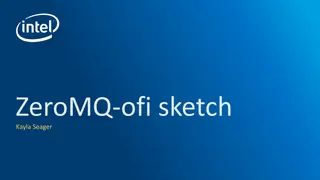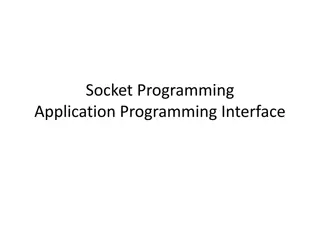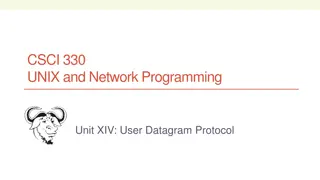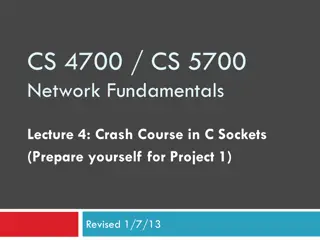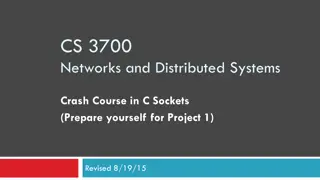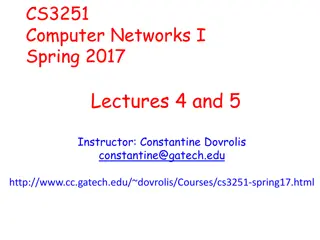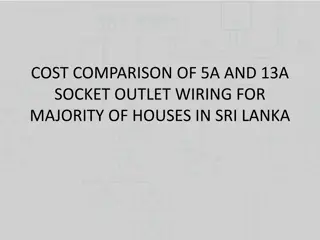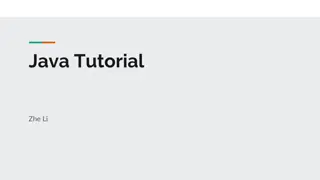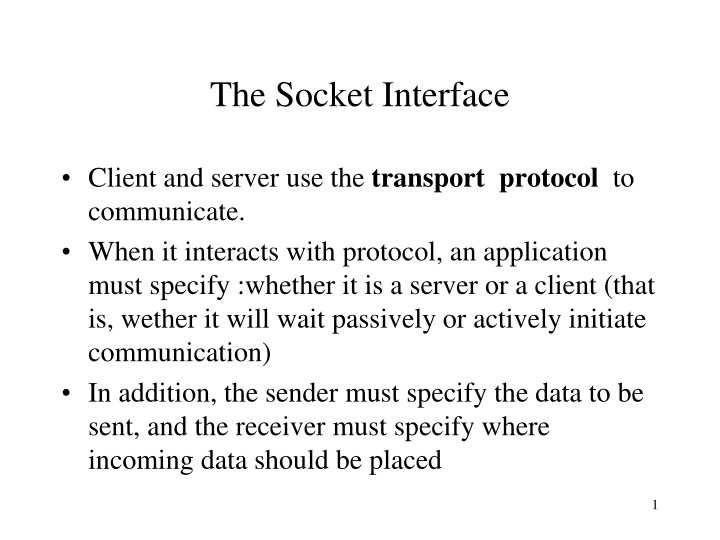
Socket Interface and Communication Protocols
Explore the world of socket interface and communication protocols, including the role of APIs in application interactions, the significance of socket libraries in different operating systems, and socket properties such as communication domain, semantic characteristics, and connection types. Learn about the fundamental concepts of server-client communication and the importance of specifying data transfer in network interactions.
Download Presentation

Please find below an Image/Link to download the presentation.
The content on the website is provided AS IS for your information and personal use only. It may not be sold, licensed, or shared on other websites without obtaining consent from the author. If you encounter any issues during the download, it is possible that the publisher has removed the file from their server.
You are allowed to download the files provided on this website for personal or commercial use, subject to the condition that they are used lawfully. All files are the property of their respective owners.
The content on the website is provided AS IS for your information and personal use only. It may not be sold, licensed, or shared on other websites without obtaining consent from the author.
E N D
Presentation Transcript
The Socket Interface Client and server use the transport protocol to communicate. When it interacts with protocol, an application must specify :whether it is a server or a client (that is, wether it will wait passively or actively initiate communication) In addition, the sender must specify the data to be sent, and the receiver must specify where incoming data should be placed 1
The interface used by an application is known as an Application Program Interface (API). An API defines a set of operations that an application can perform when interacting with protocol software and details such as arguments required. Usually an API contains a separate procedure for each logical function (for example, an API might contain a procedure that is used to establish communication and another procedure that is used to send data) 2
The protocols specify the general operations that should be provided, and allow each O.S. to define the specific API an application uses to perform the operation. The socket API is a de facto standard. Is is available for many O.S. (e.g. Microsoft s windows system, various Unix systems). The socket API originated as part of the BSD Unix O.S. 3
Socket and Socket Library In BSD UNIX and in the systems derived from it, socket functions are part of the O.S. itself. In different O.S., instead to modifying their basic O.S. vendors created a socket library that provides the socket API. That is, the vendor created a library of procedures with the same name and arguments of the socket functions. A socket library can provide applications with a socket API on a computer system that does not provide native sockets. When an application calls one of the socket procedures the control passes to a library routine that makes one or more calls to the underlyng operating system to implement the socket function. 4
Socket properties Communication domain. PF-INET :internet domain PF-UNIX :Unix O.S. domain Semantic characteristics of the communication. reliability, one to one communication, one to many communication . Local and remote addresses representation A generic format is used to represent the addresses to be assigned to the sockets 5
Socket type Type: indicates the communication properties. connection-oriented (virtual channel utilization) connection-less (no virtual channel) Socket stream - Connection oriented - one-to-one simmetric communication - connection creation before the beginning of communication - connection termination at the end of communication Socket datagram - Connectionless - one-to- many asimmetric communication 6
communication domain virtual channel message 1 proc B proc A message 2 Socket stream 7
Data structure associated to a socket In the Internet domain (PF-INET) to each socket is assigned an address constituded by: the IP address of the node in which is running the process owner of the socket. the number of the port to which the socket is associated . in order to communicate with others processes each process must: to create a socket. Each socket is locally represented by a file descriptor. to specify the socket address at wich the process will accept contacts 8
Although several version have been released, the latest Berkeley code defines a sockaddr structure to have three field: struct sockaddr ( u_char sa_len; u_char sa-family; char sa-data[14]; ) Each protocol family defines the exact format of addresses used with the sa-data field of the sockaddr structure. For example, TCP/IP protocols use structure sockaddr-in to define the address: /*total length of the the address*/ /*family of the address*/ /*the address itself*/ sftruct sockaddr-in ( u-char sin-len; u-char sin-family; u-short sin-port; struct in-addr sin-addr; char sin-zero[8]; ) /*total length of the the address*/ /*family of the address*/ /*protocol port number*/ /* ip address of the computer*/ /* not used (set to zero)*/ 9
Socket node: IPaddress node: IPaddress Process A Process B socket socket port Internet (TCP/IP) port The communication channel between the process A and the process B is defined by <protocol; IPlocal address; local port; IPremote address; remoteport > 10
Socket data structure A socket is created into a communication domain(Internet or Unix domains) . Domain - Protocol Family: Internet (or AF_INET, Address Family Internet) socket data structure family: PF_INET service: SOCK_STREAM local IP: 137.204.57.33 remote IP: .... local port: 12345 remote port: ..... pgid: .................... socket type: STREAM or DATAGRAM socket local address (the address format results from the socket communication domain) Set of processes associated to the socket 11
Procedures that implement the socket API The Socket Procedure sd = socket (domain, type, protocol); The socket procedure creates a socket and returns an integer descriptor domain specifies the communication domain (es.AF_INET) type specifies the type of communication the socket will use (es. SOCK_STREAM or SOCK_DGRAM) protocol specifies a particular transport protocol used with the socket In the communication channel the procedure specifies the used protocol <protocol; IP local address; local port; IP remote address; remoteport > 12
bind procedure When created, a socket has neither a local address nor a remote address bind (sd, localaddr, addrlen); A process uses the the bind procedure to supply the local address at wich the process will wait for contacts. sd is the descriptorof the socket that has been created, but not previously bound. localaddr is a structure that specifies the local address to be assigned to the socket. addrlen is an integer tha specifies the length of the address. In the communication channel the procedure specifies : <protocol; IP local address; local port ; IP remote address; remote port> 13
connection-oriented communication (socket STREAM or TCP) client and server: asimmetric communication 1) server and client must create each one a socket and specify their address (socket and bind procedures) 2) a virtual channel must be created betweeen the two sockets 3) communication 4)socket shutdown 14
The Listen Procedure (Server) After creation, the socket is placed in passive mode so it can be used to wait for contacts from clients. To do so, a server calls the listen procedure listen (sd , queuesize) sd is the descriptor of a socket that has been created and bound to a local address. queuesize specifies a length for the socket s request queue. The O.S.builds a separate request queue for each socket. Initially the queue is empty. As requests arrive from clients, each is placed in the queue; when the server asks to retrieve an incoming request from the socket, the system returns the next request from the queue. If the queue is full when a request arrives, the system rejects the request. 15
The Connect procedure (Client) Clients use procedure connect to establish connection with a specific server connect (sd, saddress, saddresslen) ; - sd is the descriptor of a socket on the client computer to use for the connection. - saddress isa sockaddress structure that specifies the server address and port number - saddresslen specifies the length of the server s address measured in bytes - the client process may be suspended as a consequence of a call of connect In the communication channel the procedure specifies : <protocol;IP local address; local port ; IP remote address; remote port> 16
The Accept procedure (Server) A server that use a connection-oriented transport protocol must call procedure accept to accept a connection request newsock=accept (sd , caddress, caddreslen) sd is the descriptor of a socket the server has created and bound to a specific port. caddress isthe address of a structure of type sockaddress. caddresslen is a pointer to an integer. -If a request is present in the queue, accept estracts from it the first request and creates a new socket for the connection and returns the descriptor of the new socket to the caller. - If the queue is empty the server process is suspended. 17
connection oriented communication node: IP address node: IP address Client process Server process Server socket (sd) listen() + accept() socket client new socket client port network (TCP/IP) server port 18
virtual channel creation client process asc asc=socket( ..) Connecti on request bind(asc.) csd csd=socket ( ) connect(csd. Listen(asc ) ssd=accept(asc . ssd virtual channel communication > comunication 19
The Close Procedure The close procedure tells the system to terminate the use of a socket. It has the form: close(socket) where socket is the descriptor for a socket being closed If the socket is using a connection oriented transport protocol, close terminates the connection before closing the socket. . Closing the socket immediately terminates its use . The descriptor is released, preventing the process from sending more data and transport protocol stops accepting incoming messages directed to the socket, preventing the application to receiving more data. 20
At the end of a communication session, the connection can be closed using the procedure: shutdown (socket, mode) sd is the socket descriptor associated to the channel terminal. mode defines the closure modalities. It is possible to close the channel only in a direction (value 0 for the reception, value 1 for the trasmission) or in both directions (value 2). If both directions are closed the sd socket is deleted. 21
The Send, Sendto Procedures Both clients and servers need to send information. If the socket is connected, procedure send can be used to transfer data. Send( socket, data, length) Socket is the descriptor of a socket to use. Data is the address in memory of the data to send. Length is the number of octects of data. Sendto and Sendmgs allow a client or a server to send a message using an an connected socket Sendto(socket, data, length , destaddress, addresslength) Destaddress and addresslength specify the address of a destination address and the length of that address. 22
The Recv, Recvfrom Procedures A client and a server each need to receive data sent by the other. In the case of a connected socket: recv( socket buffer, length) socket is the descriptor of a socket from which data is to be received , buffer is the addreess in memory in which the incoming message should be placed, length is the size of the buffer. In the case of a not connected socket, it can be used to receive messages from an arbitrary set of clients. recvfrom(socket, buffer, length, sndraddr, saddrlen. The first three arguments correspond to the arguments of recv, the two additional are used to record the sender s IP address 23
Read and write with sockets Socket API was originally designed to be part of UNIX, which uses read and write fot I/O. Consequently, sockets also allow applications to use read and write to transfer data. Read and write do not have arguments that permit the caller to specify a destination. (one to one communication schema). It is sufficient to specify only the socket descriptor associated to the local socket. Read and write have three arguments: a socket descriptor, the location of a buffer in memory used to store data and the length of the memory buffer. A server can send a message to a client in the following way (connected socket) int asc, sd; char msg[6] = Ciao! ; <creazione socket ed apertura del canale> write (sd,msg,6) 24
Client process # include <sys/types.h> #include <netinet/in.h> #include <sys/socket.h> struct sockaddr_in *D, *server; char msg[2000]; int sd, l; int main() { sd=socket(AF_INET,SOCK_STREAM,0); <server address initialization> /* establish connection*/ connect(sd,&server,l); <msg message creation>; } write(sd, msg,2000); /* message sending*/ read(sd,ris, 2000); /* answer receiving */ shutdown (sd,2); /* connection closing*/ 25
Server process #include <sys/types.h> #include <netinet/in.h> #include <sys/socket.h> struct sockaddr_in *M, *my; char msg[BUFFERSIZE], ris[2000]; int asc, l,sd, addrlen ; int main() { asc=socket(AF_INET,SOCK_STREAM,0); <address initialitation> l=sizeof(struct sockaddr_in); bind (asc,&my,l); /* address assigning*/ listen(asc, 100); /*request queue creating */ sd=accept(asc, M, &addrlen); /* channel opening*/ read(sd, msg, 2000); /* message receiving*. < creation of ris answer> write(sd, ris, 2000); /* answer sending*/ } 26
Client process int csd; char msg[6]; < socket creation and channel definition>; read (ssd,msg,6); The sockets are blocking: if the read is executed when no messages are present in the channel,the process is suspended. In TCP protocol messages are not separated. The channel contents is considered as a non structured sequence of bytes. Agreement between the two processes on the characteristics of the messages (for ins., prefixed constant lenght). 27
Client process # include <sys/types.h> #include <netinet/in.h> #include <sys/socket.h> struct sockaddr_in *D, *server; char msg[2000]; int sd, l; int main() { sd=socket(AF_INET,SOCK_STREAM,0); <server address initialization> /* establish connection*/ connect(sd,&server,l); <msg message creation>; } write(sd, msg,2000); /* message sending*/ read(sd,ris, 2000); /* answer receiving */ shutdown (sd,2); /* connection closing*/ 28
Server process #include <sys/types.h> #include <netinet/in.h> #include <sys/socket.h> struct sockaddr_in *M, *my; char msg[BUFFERSIZE], ris[2000]; int asc, l,sd, addrlen ; int main() { asc=socket(AF_INET,SOCK_STREAM,0); <address initialitation> l=sizeof(struct sockaddr_in); bind (asc,&my,l); /* address assigning*/ listen(asc, 100); /*request queue creating */ sd=accept(asc, M, &addrlen); /* channel opening*/ read(sd, msg, 2000); /* message receiving*. < creation of ris answer> write(sd, ris, 2000); /* answer sending*/ } 29
Socket datagram As the communication is connection-less, the procedures called by a process are create and bind. Procedures sendto e recvfrom are used by processes to send and receive messages. sendto(sd, data, length, flags,destaddress, addresslen) sd is the descriptor of a socket to use data is the address in memory of the data to be send; length isan integer that specifies the number of bytes of data flags contains bits that request special options about the message transport; destaddress specifies the address of a destination; addresslength is the length of the address 30
recvfrom(sd, buffer,length,flags,sndraddr,saddrln) sd is the descriptor of a socket from wich data is to be received buffer is the address in memory in which the incoming message should be placed; length specifies the size of the buffer; flags allow the caller to control details about the message transport. sndraddr and saddrln are used to record the sender s address 31
The recvfrom can block the process, if the message is not available; Differently from the case of connection oriented communication the communication procedures require specific parameters to identify the addresses of the partnes in the communication. to send a message it is necessary to specify the address of the receiver; to receive a message it is necessary that the recvfrom provides the address of the sending process. to close a datagram socket it is possible to utilize the system call shutdown, or the system call close 32
Connection-less communication (socket DATAGRAM) Server Process socket() Client Process bind() socket() recvfrom() 1 <request wait> sendto() <processing> 2 sendto() recvfrom() <answer wait> close() close() 33
Client include <sys/types.h> #include <netinet/in.h> #include <sys/socket.h> struct sockaddr_in *D, *my; char msg[2000], ris[BUFFERSIZE]; int sd, l, addrlen; main() { sd=socket(AF_INET,SOCK_DGRAM,0); <my address initialization> l=sizeof(struct sockaddr_in); bind (sd,&my,l); /* message sending to the server : */ sendto (sd, msg, 2000, 0, D,l); /* answer receiving recvfrom (sd, ris, BUFFERSIZE,0, D, &addrlen); ... close(sd); } 34
server #include <sys/types.h> #include <netinet/in.h> #include <sys/socket.h> struct sockaddr_in *M, *my; char msg[BUFFERSIZE], ris[2000]; int sd, l, addrlen; main() { sd=socket(AF_INET,SOCK_DGRAM,0); < my address initialization > l=sizeof(struct sockaddr_in); bind (sd,&mio,l); addrlen =l; /* message receiving:*/ recvfrom (sd, msg, BUFFERSIZE,0, M, &addrlen); < answer ris evaluation> /*answer sending:/ sendto (sd, ris, 2000, 0, M, addrlen); ... close(sd); } 35
Controlled by the application manager Controlled by the application manager Process Process Socket Socket Controlled by operating system Controlled by operating system TCP buffer, variables TCP buffer, variables Internet Host or server Host or server 36
Socket properties STREAM sockets require a connection DATAGRAM sockets are connectionless Reliability problems : STREAM sockets are based on TCP and the are reliable. DATAGRAM sockets are based on UDP and then they are not reliable. Performance: STREAM sockets are more expensive with reference to the DATAGRAM sockets. 37









